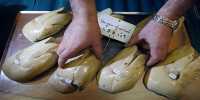As a mark of their friendship, Stone Age besties may have given and wore bits of ornate slate rings. According to recent study, these ornaments might have been intentionally shattered and presented as a mark of a social tie, similar to modern-day friendship bracelets or broken heart BFF necklaces. Nothing screams friendship like a bit of shattered rock, after all. The 5,000-year-old rings were discovered in Finland, and their discovery was the subject of a paper published in the Journal of Archaeological Method and Theory.
The rings were widely created and shared by hunter-gatherer cultures in north-eastern Europe as early as the 4th millennium BCE. Because the rings are composed of slate or tuffs, both of which are fragile and easily broken, it’s common to suppose that they were shattered due to natural wear and tear. The latest study, on the other hand, shows differently. The rings were never meant to be entire, according to the writers. Instead, they were made to be broken apart and turned into pendants, which were most likely meant to represent individual and community social interactions.
A considerable percentage of the rings – one-third – were determined to have come from Lake Onega in Russia, hundreds of kilometers away from the discovery site in Finland. Some of the fragments may indicate social interactions developed within this network, as they were carried across Europe as part of a large trade network. The scientists from the University of Helsinki and the University of Turku were able to verify the rings were purposefully shattered and subsequently worn as personal decorations after methodically fitting the shards back together, examining their geochemical makeup, and looking for evidence of wear. At the ends of shards, they discovered indications of tool use, as well as finishing elements such as fixing holes.
Fragments from the same ring were frequently discovered in two separate places and had distinct finishes, suggesting that they were worn by two different persons, maybe a pair of long-distance friends. “These bits of the same thing might reveal two people’s handprints and preferences.” “Perhaps they wore the pendants as a symbol of an established bond,” lead author Dr. Marja Ahola said in a statement.
And it’s possible that the rings were designed to commemorate more than simply personal ties. Fragments were found in abundance in major, central settlement sites — presumably meeting locations for social events. The authors speculate that tokens were provided to both the venues and the guests of such meetings, explaining their popularity in these places.
The scientists also discovered evidence that the fragments were utilized to build a link between the living and the dead. One piece was discovered at the settlement site, while another was discovered at a nearby burial site, not from the same ring but fashioned from the same stone and using the same manufacturing procedure.
“What we’re seeing here might be one method to keep the living and the dead connected.” This is also the first time a definite material link has been established between a specific dwelling and a burial location. To put it another way, the folks who lived there most likely buried their deceased nearby,” Ahola added. Much has changed in the previous 5,000 years, yet our urge to demonstrate our ties with others via jewelry has been constant, from Stone Age slate to 21st-century baubles.
















